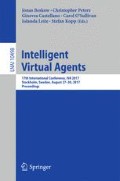Abstract
Recent advances in crowd simulation models attempt to recreate realistic human behaviour by introducing psychological phenomena in virtual agents. In this direction, psychology studies on personality traits, emotions and emotional contagion attempt to cope with emerging behaviours such as panic spreading and fight picking. This work depicts a way to introduce a model of emotional contagion in the scope of crowd simulation. Challenges regarding the applicability of an emotional contagion model considering great number (hundreds or thousands) of agents are depicted. Results shows that the dynamics of space and time creates emergent behaviour in crowd agents that are tuned with emotional contagion phenomena and crowd behaviour as described by literature.
Preview
Unable to display preview. Download preview PDF.
References
Goldberg, L.R.: An Alternative “Description of Personality”: The Big-Five Factor Structure. Journal of Personality and Social Psychology 59(6), 1216–1229 (1990)
Eysenck, H.J., Eysenck, M.W.: Personality and Individual Differences: A Natural Science Approach. Plenum Press, New York (1985)
Durupinar, F., Allbeck, J., Pelechano, N., Badler, N.: Creating Crowd Variation with the OCEAN Personality Model. In: Padgham, Parkes, Müller, Parsons (eds.) Proceedings of the 7th International Joint Conference on Autonomous Agents and Multiagent Systems(AAMAS 08), pp. 1217–1220 (2008)
Lhommet, M., Lourdeaux, D., Barthès, J.P.: Never alone in the crowd: a microscopic crowd model based on emotional contagion. In: 2011 IEEE/WIC/ACM International Conferences on Web Intelligence and Intelligent Agent Technology, vol. 2, pp. 89–92 (2011)
Guy, S.J., Kim, S., Lin, M.C., Manocha, D.: Simulating heterogeneous crowd behavior using personality trait theory. In: Eurographics / ACM SIGGRAPH Symposium on Computer Animation, pp. 43–52 (2011)
Durupinar, F., Güdükbay, U., Aman, A., Badler, N.I.: Psychological Parameters for Crowd Simulation: From Audiences to Mobs. IEEE Transactions on Visualization and Computer Graphics 22(9), 2145–2159 (2016)
Reynolds, C.W.: Flocks, herds and schools: a distributed behavioral model. In: SIGGRAPH 1887: Proceedings of the 14th Annual Conference on Computer Graphics and Interactive Techniques, pp. 25–34. ACM, New York (1987)
Helbing, D., Molnar, P.: Social Force Model for Pedestrian Dynamics. Physical Review E. 51, 4282–4286 (1995)
Musse, S.R., Thalmann, D.: Hierarchical Model for Real Time Simulation of Virtual Human Crowds. IEEE Transactions on Visualization and Computer Graphics 7(2), 152–164 (2001)
Pelechano, N., Allbeck, J.M., Badler, N.I.: Controlling individual agents in high-density crowd simulation. In: Proceedings of the 2007 ACM SIGGRAPH/Eurographics Symposium on Computer Animation, pp. 99–108 (2007)
Dodds, P.S., Watts, D.J.: A generalized model of social and biological contagion 232(4), 587–604 (2005)
Tsai, J., Bowring, E., Marsella, S., Tambe, M.: Emotional contagion with virtual characters. In: Proceedings of the 11th International Conference on Autonomous Agents and Multiagent Systems, vol. 3, pp. 1193–1194 (2012)
Bosse, T., Duell, R., Memon, Z.A., Treur, J., Wal, C.N.: A multi-agent model for emotion contagion spirals integrated within a supporting ambient agent model. In: Yang, J.-J., Yokoo, M., Ito, T., Jin, Z., Scerri, P. (eds.) PRIMA 2009. LNCS (LNAI), vol. 5925, pp. 48–67. Springer, Heidelberg (2009). doi:10.1007/978-3-642-11161-7_4
Durupınar, F.: From audiences to mobs: Crowd simulation with psychological factors. Bilkent University (2010)
Hatfield, E., Cacioppo, J.T., Rapson, R.L.: Emotional Contagion. Cambridge University Press, New York (1994)
Fredrickson, B.L., Joiner, T.: Positive emotions trigger upward spirals toward emotional well-being. Psychological Science 13(2), 172–175 (2002)
Poggi, I.: Enthusiasm and its contagion: nature and function. In: Paiva, A.C.R., Prada, R., Picard, R.W. (eds.) ACII 2007. LNCS, vol. 4738, pp. 410–421. Springer, Heidelberg (2007). doi:10.1007/978-3-540-74889-2_36
Dezecache, G., Conty, L., Chadwick, M., Philip, L., Soussignan, R., Sperber, D., Grèzes, J.: Evidence for unintentional emotional contagion beyond dyads 8(6), e67371 (2013)
Bon, G.L.: The Crowd: A Study of the Popular Mind. Macmillan, Criminology series (1896)
Cosmides, L., Tooby, J.: Evolutionary psychology and the emotions. In: Handbook of emotions, vol. 2, pp. 91–115 (2000)
Spoor, J.R., Kelly, J.R.: The Evolutionary Significance of Affect in Groups: Communication and Group Bonding 7 (4), 398–412 (2004)
Bicho, A.L.: Da modelagem de plantas àdinâmica de multidões: um modelo de animação comportamental bio-inspirado. University of Campinas - UNICAMP, Campinas (2009)
Hall, E.T.: The Hidden Dimension. A Doubleday anchor book. Anchor Books (1990)
Bosse, T., Duell, R., Memon, Z., Treur, J., van der Wal, C.N.: Agent-Based Modeling of Emotion Contagion in Groups. Cognitive Computation 7(1), 111–136 (2015)
Author information
Authors and Affiliations
Corresponding author
Editor information
Editors and Affiliations
Rights and permissions
Copyright information
© 2017 Springer International Publishing AG
About this paper
Cite this paper
Borges Fortes Neto, A., Pelachaud, C., Musse, S.R. (2017). Giving Emotional Contagion Ability to Virtual Agents in Crowds. In: Beskow, J., Peters, C., Castellano, G., O'Sullivan, C., Leite, I., Kopp, S. (eds) Intelligent Virtual Agents. IVA 2017. Lecture Notes in Computer Science(), vol 10498. Springer, Cham. https://doi.org/10.1007/978-3-319-67401-8_7
Download citation
DOI: https://doi.org/10.1007/978-3-319-67401-8_7
Published:
Publisher Name: Springer, Cham
Print ISBN: 978-3-319-67400-1
Online ISBN: 978-3-319-67401-8
eBook Packages: Computer ScienceComputer Science (R0)

